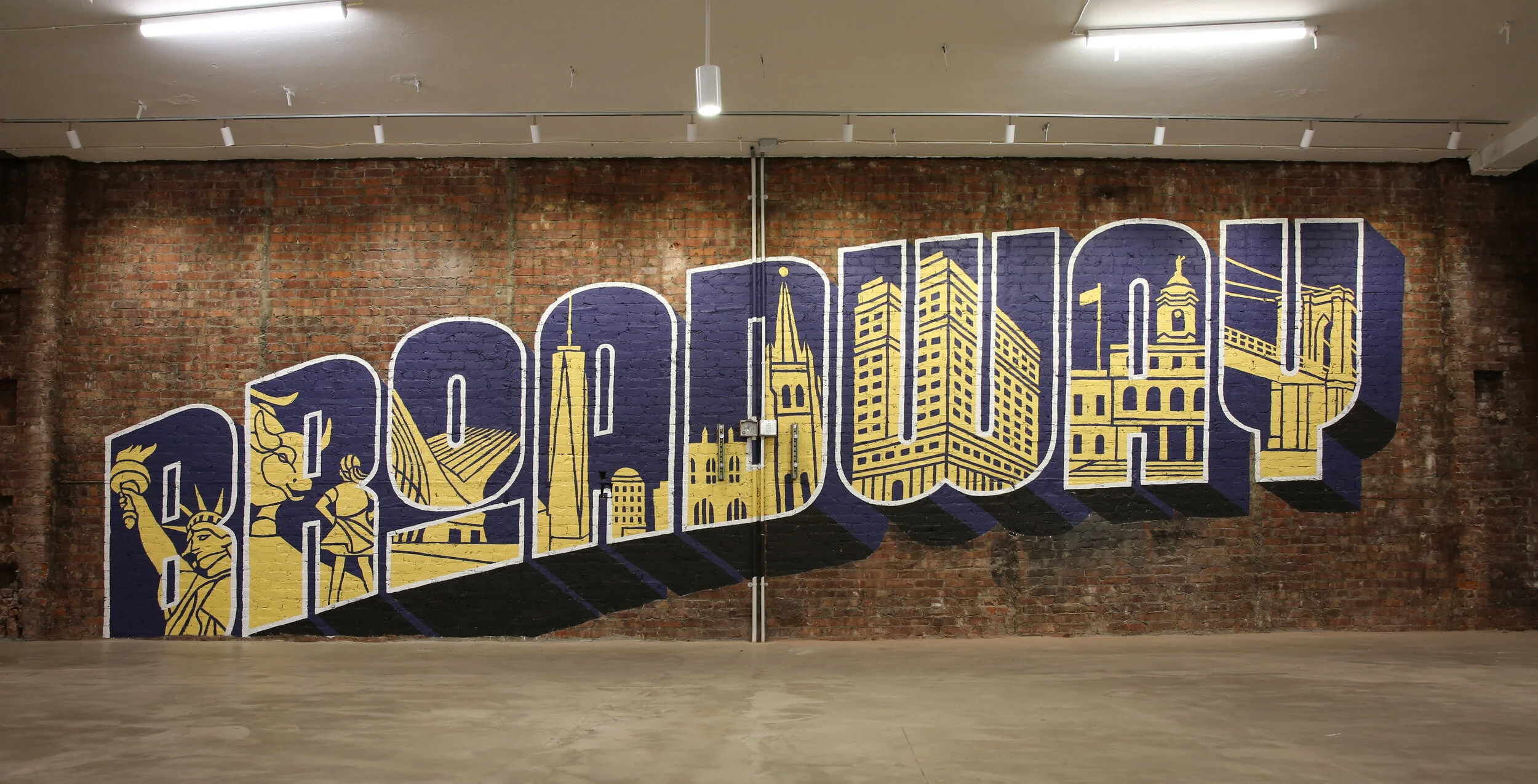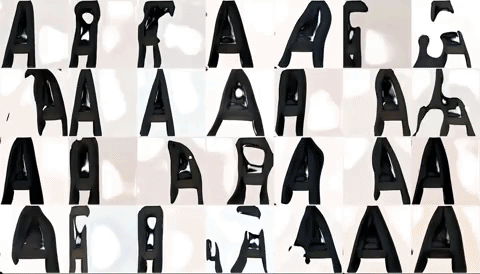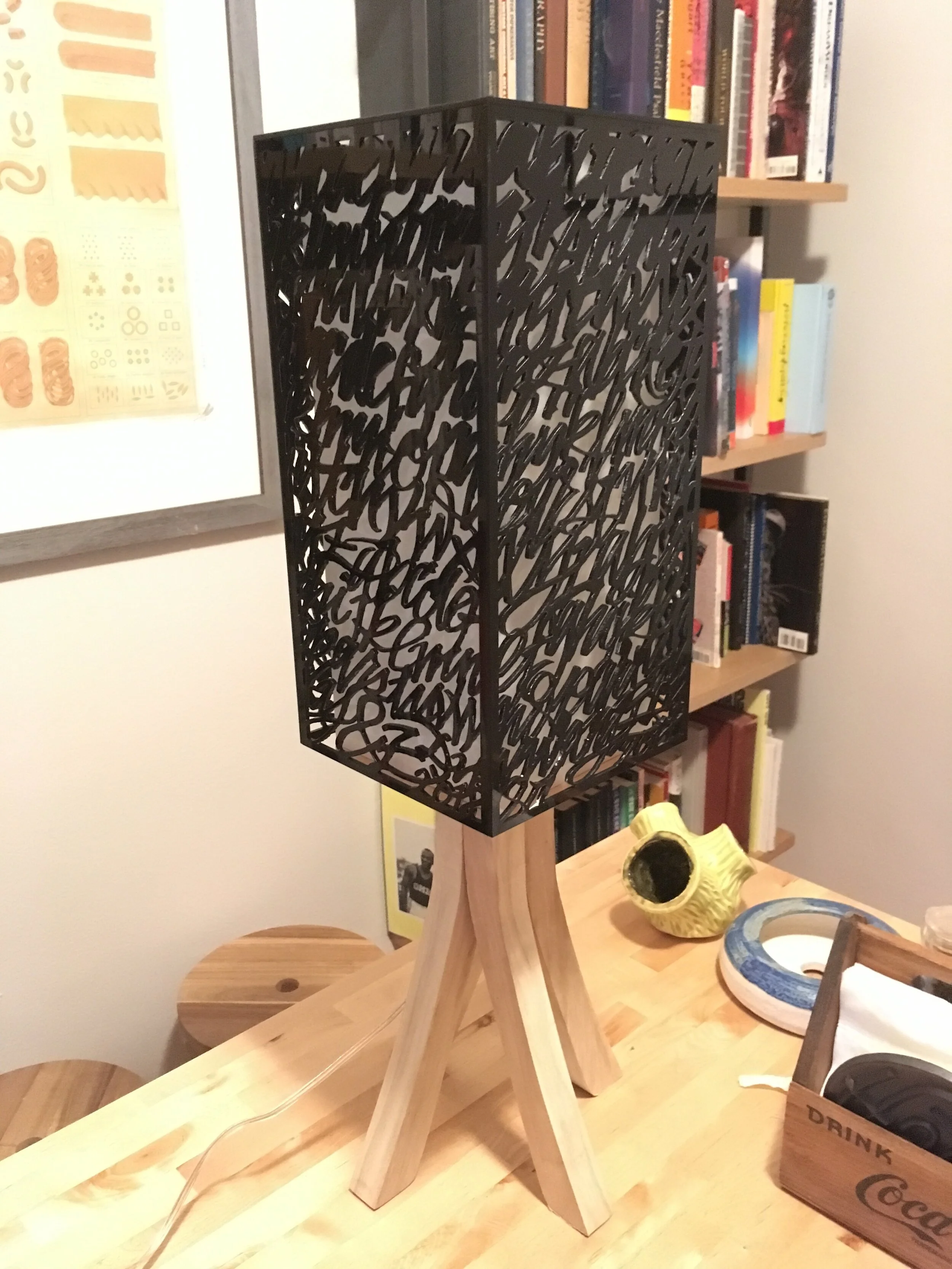Letterforms With Lynne
As a type designer and educator, Lynne Yun is so much more. She not only has a masterful grip of her calligraphy pens, she is also a skilled coder who experiments with generative art. Her sunny demeanor, extensive curiosity and exploration of all the mediums inspires us to want to learn and know more. Below, we chat with Lynne about her love of letters, her blossoming interest in coding, and her recent online type design education series.
Hui: Lynne, it’s been awhile since we last saw each other, but every time I see you, it never feels like a lot of time has passed! So glad to have you here and thanks for sharing your time with us to chat. Speaking of time, I think of you as someone having Beyoncé hours; you are so productive that I wonder if you live on a different plane with more hours than all of us! To start, could you tell us a little about yourself?
Lynne: Yeah! I feel it gets harder and harder because I have so many hobbies and sometimes they become jobs, so I have to rejigger my intro. I still think the core of what I do is related to type and specifically, letterforms.
My formal background is in graphic design. I went to SVA (School of Visual Arts) for graphic design, then worked at Apple for packaging design, which is where I met you, and later on decided to learn type design at Type@Cooper. After that, I bounced around advertising agencies and eventually landed a type design job at Monotype, where I was for two and a half years. Recently I wanted to learn more about technology, so I was doing residency programs at places like the School for Poetic Computation. Right now, I am in my 2nd year at NYU’s ITP program. I’m trying to get more into the technology portion of my interest and have no idea where this will lead me!
Mural painted inside the Equitable Building on 120 Broadway in Manhattan, with each letter containing an iconic landmark that can be seen from the building
Hui: I know you as someone who’s always experimenting and trying out new things, from technology to type to design. How do you manage to switch gears so fluidly? Is there an intention behind that?
Lynne: It happens organically for me. With type, I always had a lot of random questions that pop into my head. The reason why I got into calligraphy was because I was looking at a capital A and a capital V; I wondered why it was thin on the left side of the A but thin on the right side of the V, which made no sense because they look exactly the same without the bar, just flipped. So that’s how I got into history and calligraphy. And now I know that the calligraphic traditions influence what type looks like, but how is it that I type a thing on my keyboard and it appears on my screen? Then that led me down a whole rabbit hole of technology. That’s usually how things happen for me.
Hui: Would you say it’s a curiosity for knowledge that opens these doors for you?
Lynne: Yeah, curiosity and the desire to know how things work. I was the kind of kid if something was rattling around in my Game Boy, I needed to take it apart and fix it. Sometimes you can put it back together but sometimes you can’t. That’s how I learn most things; it’s not any different from being a kid.
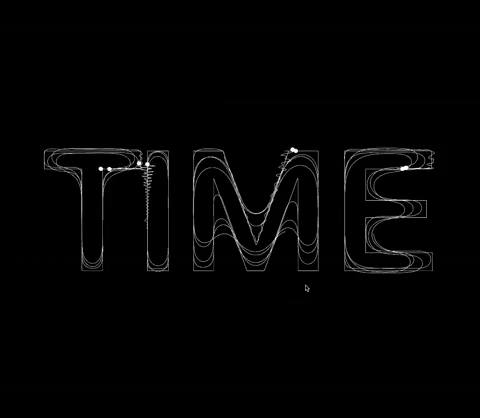
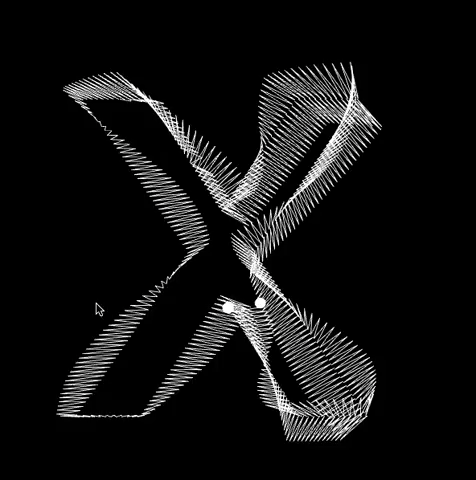
OpenFramework sketches made with manipulating font data for generative design
Hui: You do a lot of calligraphy and you teach it as well. What drew you to calligraphy? How did you gain knowledge in it?
Lynne: It came from a frustration of doing too much on the screen and wanting to do something with my hands. It started when I was at Apple, where I was eligible for tuition reimbursement for type classes. I discovered that the community was full of friendly people. When you get into something new, you just have to discover that you like hanging out with the people that are a part of it and so you stick around for a little bit longer.
Identity, hand-lettering, and packaging design for a line of four flavors of Hany's Fire Tonic, a raw apple cider vinegar infusion tonic
Hui: You straddle the line between a type designer and a graphic designer, maybe more so when I first met you. I remember your beautiful hand-lettered packaging for Hany’s Fire Tonic; how do you think of yourself as a graphic designer and type designer? How do those roles feed into each other?
Lynne: That’s the eternal question. The more I think about it, the word “graphic designer” falls further and further away from me. I don’t think of myself as a graphic designer anymore, partially because I don’t do graphic design for an income. I still very much think of myself as a type designer because that’s where I get most of my bill-paying jobs. Although the more I do things, the more I realize I enjoy doing them as opposed to just getting paid for them. That’s the line that a lot of us in commercial work have to straddle. These days I settle for, “I love technology and I love letters, and I do everything in between.”
Hui: It does bring up a lot of questions around, do we call ourselves something because we get paid for it? Is that really our moniker for the rest of our lives? I don’t have an answer for that.
Lynne: I love letters from the bottom of my heart. Partially it’s because there’s a lot of history behind it, a lot you can learn from it, and a lot you can do with it. At some point, a friend asked if I do letter-related things because that’s where I found myself in and felt compelled to keep doing that as opposed to doing something new. I think about that sometimes. If I decided to get interested in floral arrangement, could I do it? Or will I be too scared to leave my paying gigs behind?
Shirley: You can!
Lynne: I like that! (Laughs).
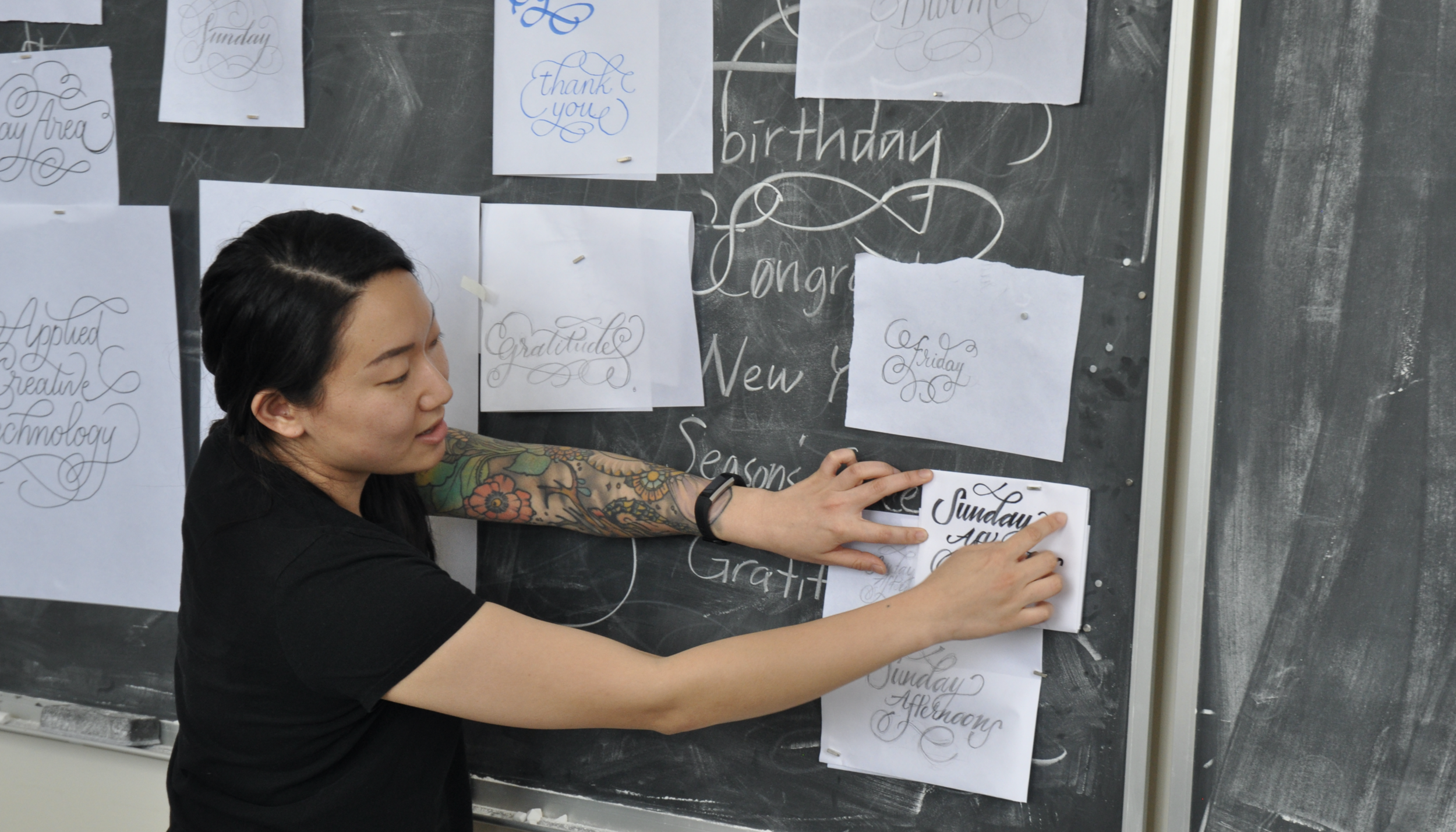
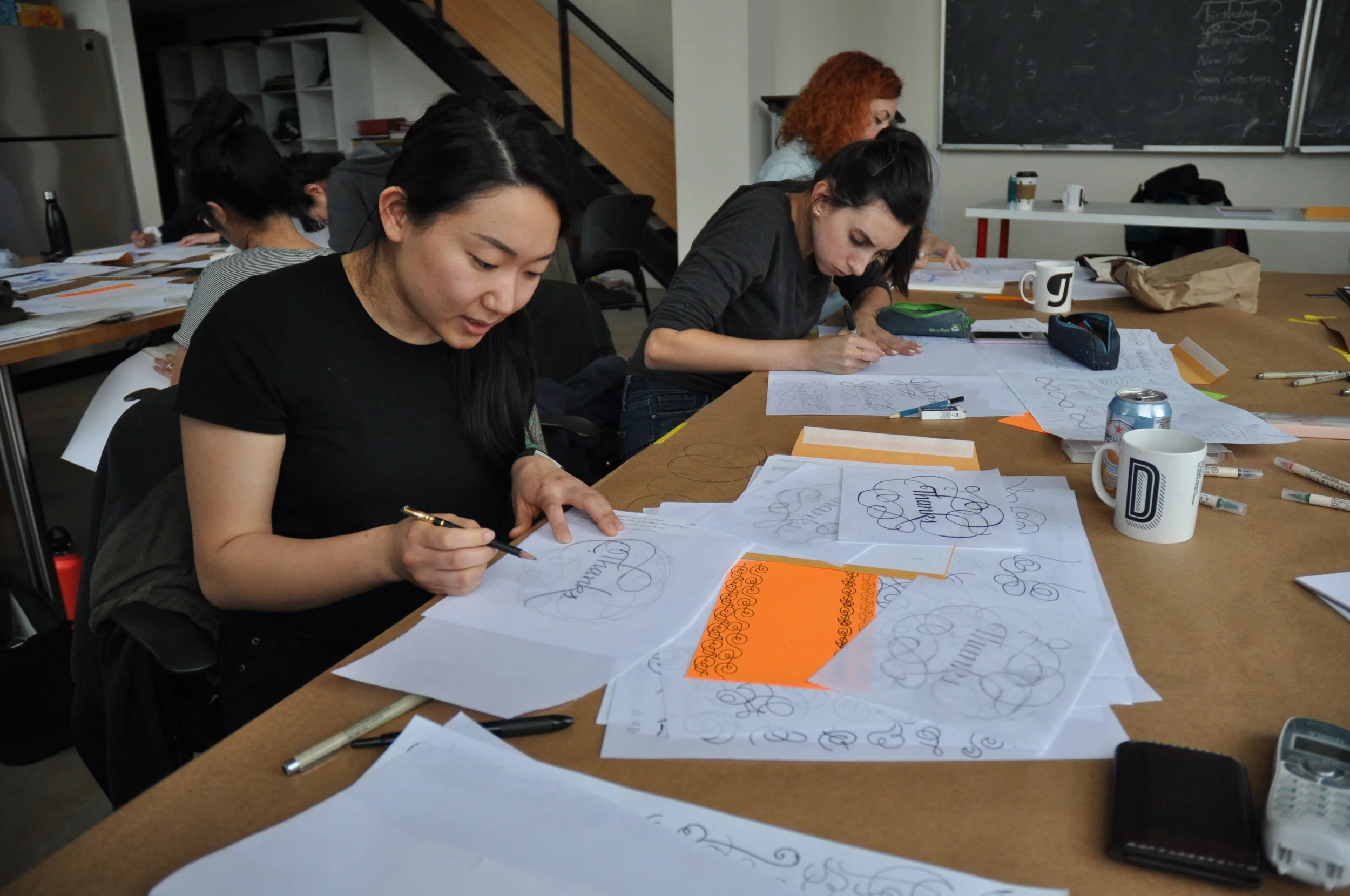
Lynne teaching a calligraphy workshop at Type@Cooper West
Photography by Kel Troughton
Hui: You currently teach at Type@Cooper and at Parsons School of Design, but you’re also a student at the ITP program in NYU. How does the dichotomy of roles as a teacher and as a student inform each other?
Lynne: If I had to pick one hobby, it would be taking classes. The pandemic in a way has worked out for me because I can now take classes that were only available in the UK, for example. I learn a lot by taking classes, and there are moments when you are a student and you wish they went a little deeper into something or you wish the 5 minute break was longer so you can get some water—there’s a lot of things I learned that help me with teaching.
The classes I teach are always changing. The first classes I taught were calligraphy workshops, which turned into experimental calligraphy, and then eventually turned into type design. Now I teach generative typography at Type@Cooper, and this semester is the first time I’m repeating a class in the entire time I’ve taught there. It’s because I would teach a class, and by the time the class has ended, which is three months later, my interests would have shifted. I have taught four different classes in a row now, and it’s my fifth semester teaching but the first time I’m repeating it.
I learn things and really get into them, but I don’t fully understand it until I teach it to someone else. It’s like a delayed reaction: student, self-study, teacher, going over a little hump, and then doing that all over again.
Flourished cards for Type Design A-Z Kickstarter supporters
Hui: So you recently started an online type education series Type Design A-Z. Could you talk about why you started that and what you hope to do with providing easy and affordable access to type design?
Lynne: The intention was simple. It started because I was teaching a class for Type@Cooper and Parsons. I had been making lectures that were asynchronous because with the onset of the pandemic, people were in various situations of disarray. Some people could only attend the recorded version and not live, which was completely understandable. I had made a lot of recorded and written content, and since both classes had similar foundations, I could put more effort into making quality recorded content, saving a lot of time across the board. That’s when I started to make the History of Latin Alphabet lecture series which I eventually put on YouTube.
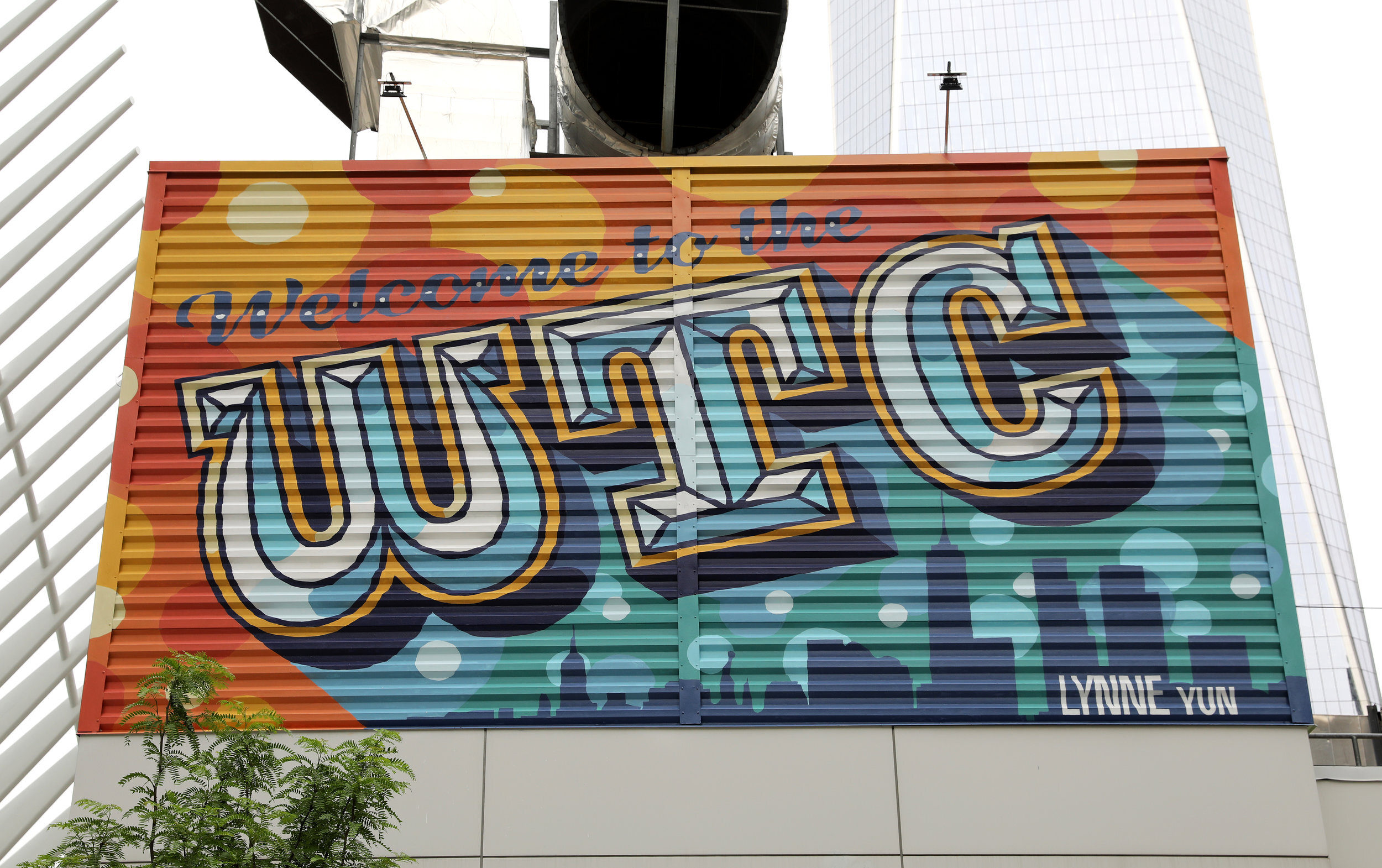
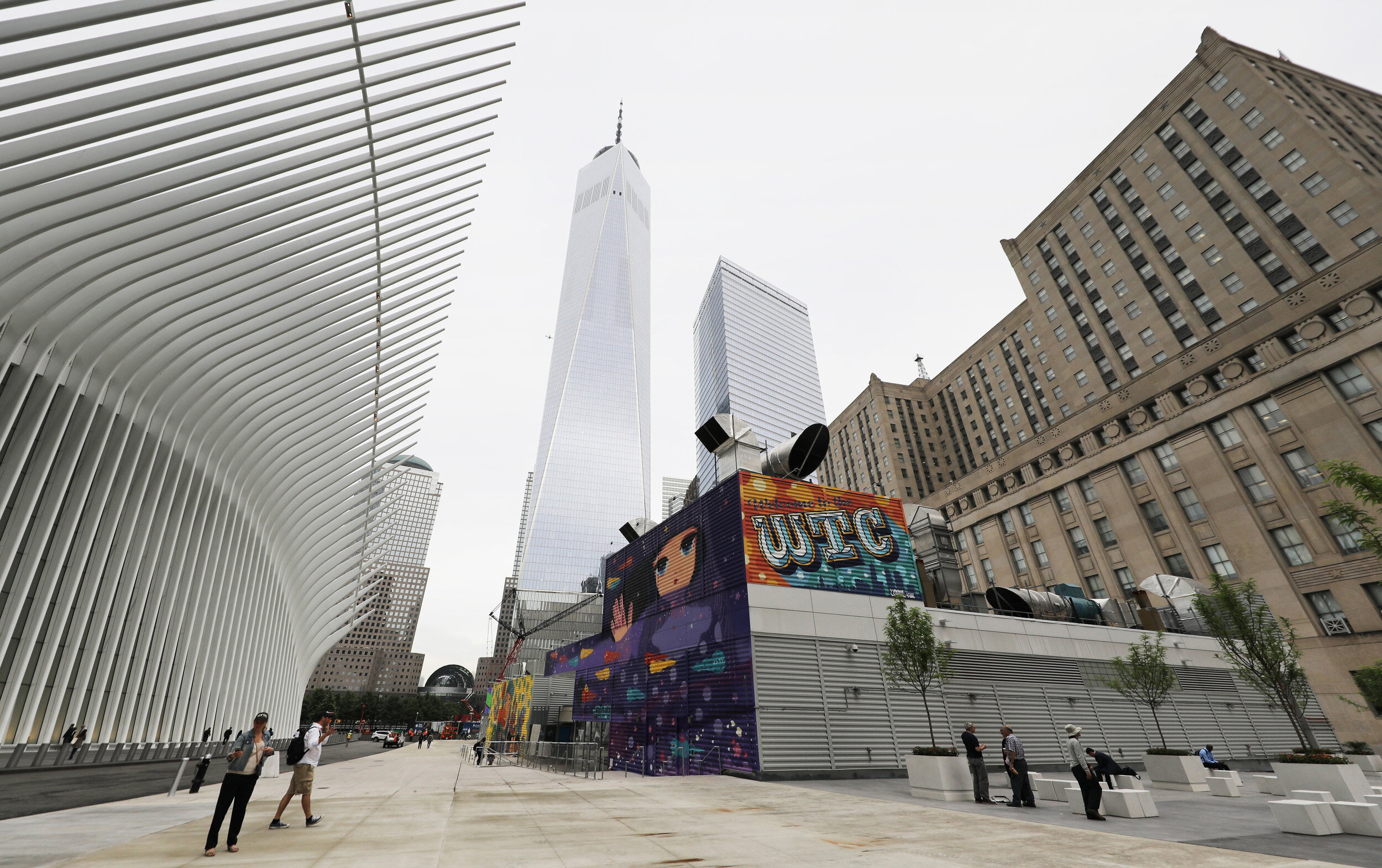
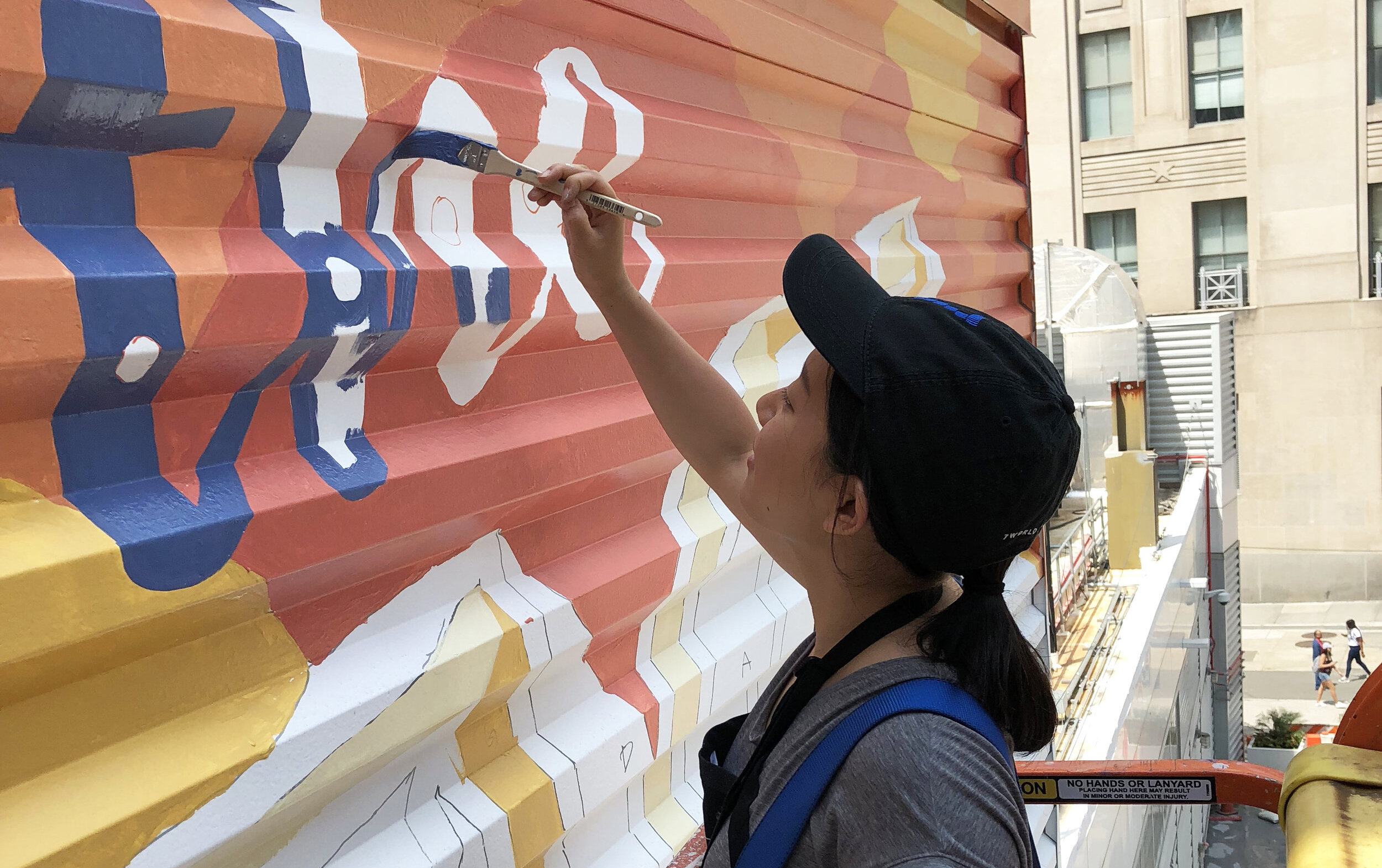
Mural for 2 World Trade Center inspired by retro “Greetings From” postcards
Partly, it was also a distraction for me. Everyone was having collective anxiety, and I was stuck at home. I needed to be making something. And it turns out I really enjoyed making pre-recorded content. I’m super introverted, and as a teacher, I have to come out of my shell and teach, but after that I can’t interact with anyone else. Recording content is nice because I can do my thing without being anxious if the person on the other end is liking it or not.
A lot of the workshops I was scheduled to teach in the summer were also cancelled. Since people had liked my pre-recorded content, I figured why don’t I just make it easier for people to learn type design? Sometimes people will email me and ask, how do I learn type design? The only thing I could tell them was, you could go to this or that program and they all cost thousands of dollars. There’s a lot of barriers associated with learning type design.
At the moment a lot of stars were aligning and I thought maybe I can fund my own class; that’s how I created the Kickstarter. I aimed for $4000 and I remembered stressing out about it the night before. After launching it, the goal was met within something like 5 hours. It was going to be a month-long class but I felt like I should make more things, stretch the goals. In the end it was funded 400% and the class ended up being a huge thing over the summer. If the community is funding it then they should be getting something back; I’m really happy with how that turned out.
Logotype design for the 2017 US Open
Hui: There’s only a few type design programs in the country and tuition is expensive. Why haven’t we seen more affordable type design classes?
Lynne: I’m not exactly sure, but a lot of it has to do with type design not being a traditional white collar job, where you could enroll in a program to learn about it. Type design was treated like a trade where you had to apprentice somewhere to learn the skills. You had to know some old dude that was a type designer, and you somehow get to work for them, and then you’d have that knowledge. Typographica or Stephen Coles did a poll on who was a full-time type designer in 2013, and there were only 300. If you divide that amongst all the countries, that’s maybe 1.2 designers per country? There was no desire for people to become type designers because they didn’t know that there was a job as such. When Type@Cooper came about, it was the first of its kind in the country. U.S. education being expensive is one of the reasons why the price tag is so high. There’s a few programs in the EU that’s more affordable, but that also requires its own bubble of privilege.
One of the things that came out of the Black Lives Matter movement was that someone compiled a list of black type designers, and the oldest of them is Joshua Darden, who’s only 41. I don’t even know how old the oldest non-white designer for Latin type is but type design has been around for hundreds of years, so it’s wild!
Johana: It’s awesome you’re democratizing type design education!
Machine learning tests trained on images of fonts and faces
Lynne: I think it also has a lot to do with my perception of education changing as I go into the tech sphere. There’s so many good open source software for various technology. Dan Shiffman and his Coding Train YouTube channel is a huge inspiration for me! He has programming tutorials on the internet for free and he’s such a good teacher. I watched hours of it and learned so much. When I tried to find type design tutorials online, either they were nonexistent, or it was a 2-hour Skillshare video that didn’t really teach much. No one needs to be a full-time type designer to know this stuff. It should be possible that whoever wanted to learn type design should be able to have the tools to do so. There’s a desire in me to learn and imagine how I feel like if I was the person on the other side of the internet and wanted to learn type design, but coming up to this giant paywall of education. It’s really sad.
When my class launched on Kickstarter, it was $25 for students and $50 for professionals, which was a low bar in general. I didn’t have much financially and when a lot of the social movements happened, that was what I thought I could give, to offer my existing class for free for people of color.
A lot of things that came out of the Type Design School happened organically. Someone contacted me and told me they really liked the class but didn’t understand English. So I looked into having Spanish captions and then figured I should have other languages too. Now I’m working on Portuguese subtitles. The most gratifying moment for me was when somebody sent me an email, saying they are partially deaf and because of that, was never able to take a lot of design classes, so they appreciated that my classes have captions. It makes me feel like I’m living in human society again, especially during Covid since I don’t see anyone physically. I feel like a hermit in my room, and it’s good to know somebody likes what I’m doing.
Shirley: I really appreciate how you’re making these things accessible to people who normally don’t have access to them.
Hui: You also recently started a studio Space Type Continuum with your partner Kevin Yeh! From the website, Space Type Continuum specializes in “the intersection of type, design, and technology.” Can you tell us what that means?
Lynne: That’s the closest description for what I want to be doing in the future. The more I do things, the more I realize I love making things digitally and I love making things with my hands, which is the “space” aspect of our studio name. “Type” is because it’s a good go-to subject for me since I know it well.
Partially it’s the idea of me wanting to make more tangible things digitally. The more familiar I get with technology, the more I realize technology can be warm. Fonts used to feel so impersonal to me. I used to think, why would I use fonts if I could letter things myself? But after I became a type designer, if you spend a lot of time making and crafting the font, it can feel as personal as a piece of lettering does. Now that I’m making software, I want to get more into that cottagecore aspect of software.
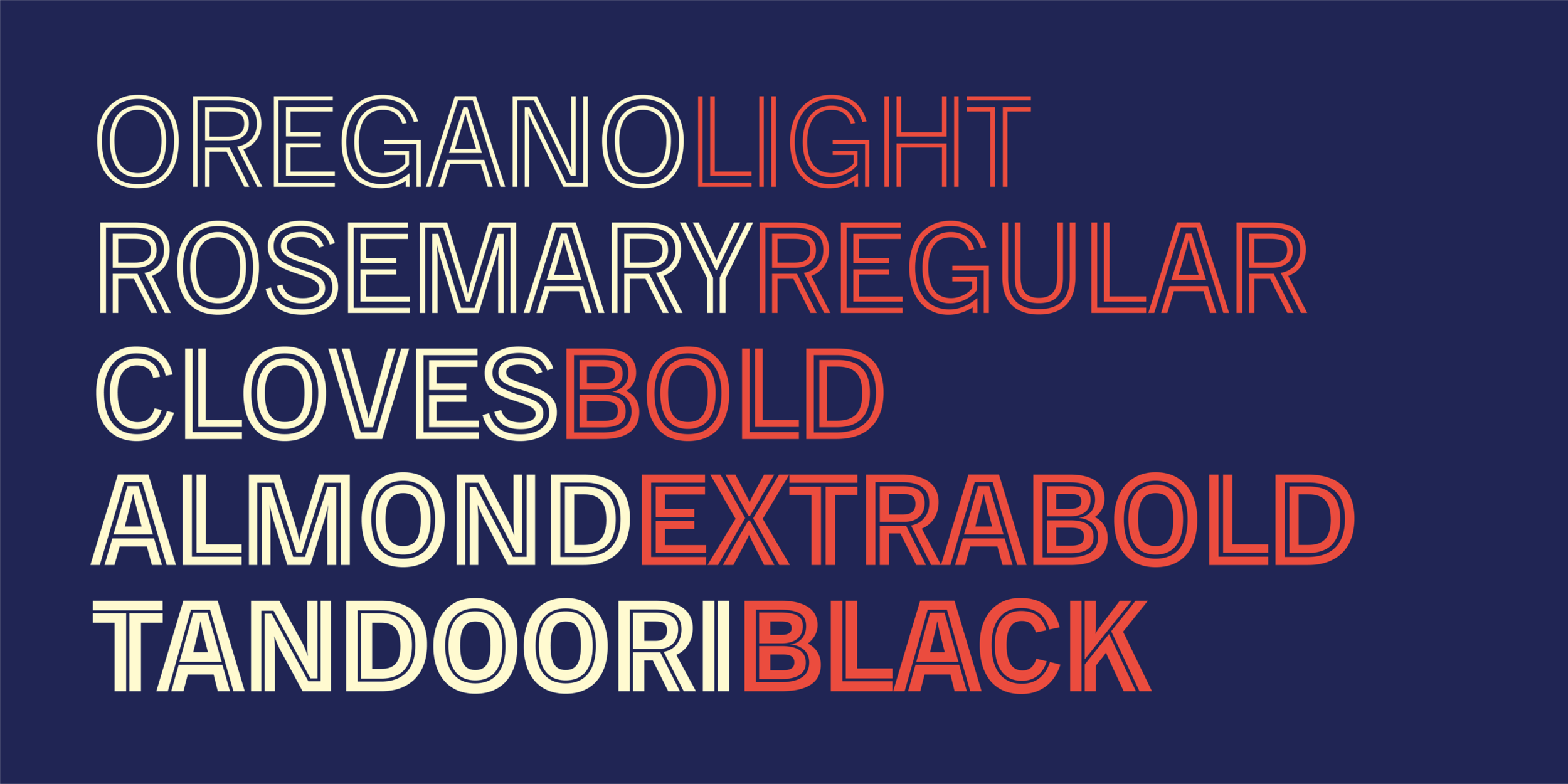

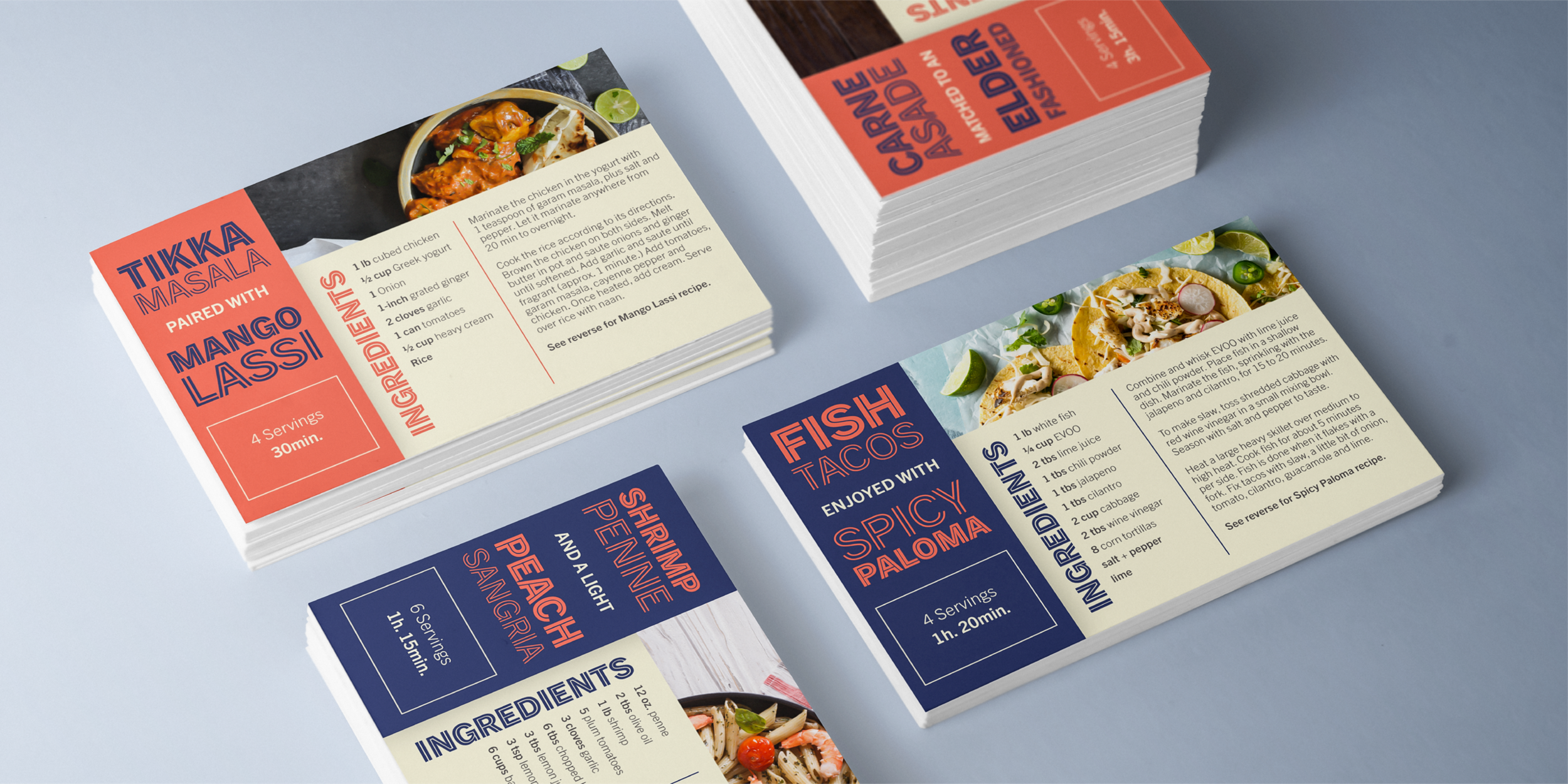
Trade Gothic Inline, a practical and versatile companion to Trade Gothic Display
Hui: What kind of projects does Space Type Continuum work on?
Lynne: We’re pretty new and we made the website just a few months ago. Right now we’re focusing on teaching; we run the Type@Cooper class together. Kevin is a proper computer science major, now a developer and software engineer; he makes things in a faster and more efficient way. Kevin once called me “the most inefficient proficient programmer.” I bring in the tinkering and curiosity and Kevin thrives in building the thing. Art and type is what I bring, and Keven brings the technology. We can span a little bit but that’s where the balance lies. Our recent focus on teaching has been great because trying to help students together is another aspect we’re figuring out. And that’s really helpful in figuring out our dynamic with clients going forward. Everything is a work in progress.
Hui: Something I remember seeing in one of your posts, your resolution in 2020 is to find your creative identity. I see you as someone who is extensively creative, you’re a type designer, education, creative coder, you also illustrate, make ceramics, work in 3d printing...what do you mean when you say creative identity? And right now what does that look like?
Lamp designed and fabricated at SVA Visible Futures Lab
Lynne: What I desire to be is always different than what I am, like everyone else. This might also be something I later figure that I never needed or wanted. When I think of people like Paula Scher or…I don’t know who our big design heroes are anymore, they’re kind of knocked down now with all these social movements (laughs). As a student, you educate yourself by looking at a lot of people’s work, and you feel as if you can see their creative identity through their work. I wish I could be that person who can say, this is my thing. But every year my thing changes and I feel like a jack of all trades and a master of none. Sometimes I wish I could passionately love something so much that it would be the end all be all. That was in the new year, but then Covid hit and nothing was important anymore.
My interests are always changing, and I have this personality where I’m always going down different rabbit holes. I wish I was a super deep specialist in something. Maybe in time I’ll realize my specialty is doing a bunch of things, but I haven’t gotten there yet.
Hui: It’s always different in how people see you versus how you see yourself. I see you as very accomplished and having a deep understanding in a lot of things, especially in type. You teach it, you’ve done it for many years, and now you’re broadening your understanding of it through technology. I think that’s just one of the many things you are deeply knowledgeable about.
Thank you so much, Lynne, for your time; we loved hearing about you and all the things you do! Please keep doing what you’re doing for the type community!
Interview by NSC

